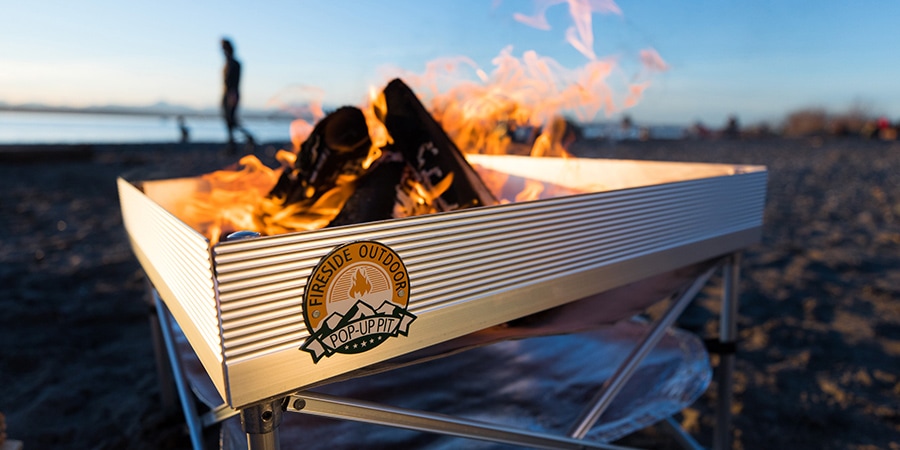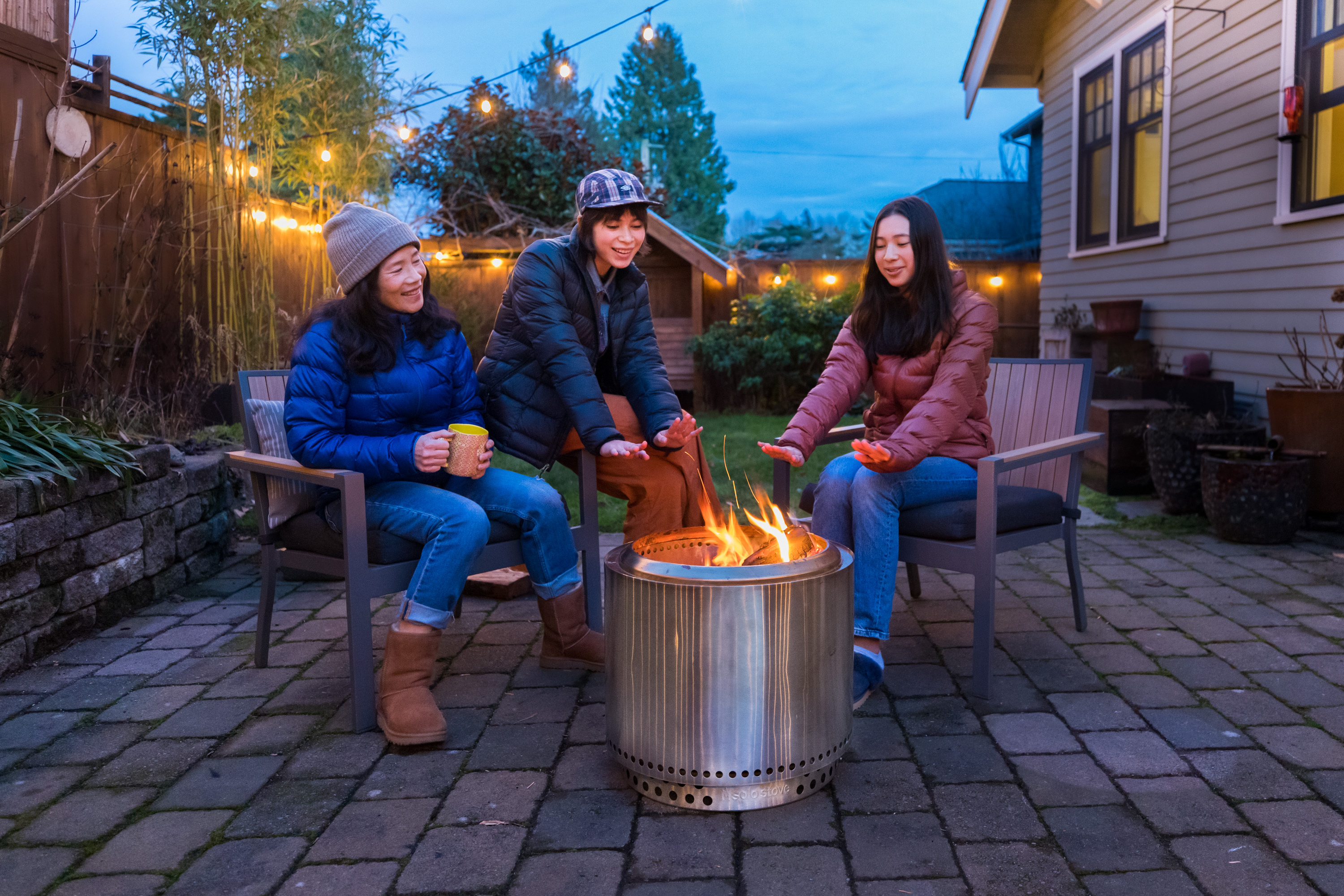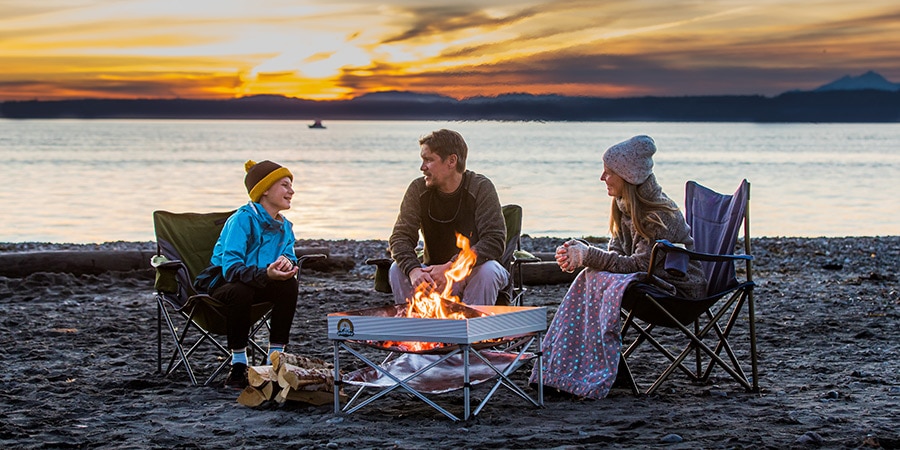Folks say a campfire is "the original television" because it's endlessly entertaining to watch flames flicker, spark and pulse. Alone or with a group, we unlock a primeval connection with ourselves and our community when we settle beside a fire. If staring into a flickering blaze is an essential part of your outdoor experience, you may want to invest in a portable fire pit, which lets you bring your campfire with you. Fire pits let you create that sense of retreat not just at the campsite, but also at home, on the beach or at a trailhead parking lot.
Fire pits are easy to light and help minimize impact on the environment. The best of the bunch features some sort of heat shield that keeps flames from singeing the ground—as an Leave No Trace strategy, they're typically superior to the traditional ring of rocks around a blackened patch of earth. Sizes vary from small, light and packable to big and gleaming. Many include a grill for easy outdoor cooking.
We tested the best portable fire pits available at REI and distilled that feedback into this guide. Most of the fire pits we tested burn wood or charcoal, but we also reviewed a propane option that's smokeless. All the options in this guide let us enjoy fire, warmth and romance, wherever we roamed. Read on to discover our member-testers' favorites—roasting forks recommended, but not required.
Note: Before starting a fire outdoors, review Leave No Trace principles and safe extinguishing practices. Only have fires when they are allowed: check the land manager's current regulations for information on where to build a fire, proper fuel to use and potential burn bans.
Test Results
For quick recommendations, check out the results of our round-robin here, or scroll down for in-depth reviews:
- Best All-Around Fire Pit: FIRESIDE OUTDOOR Pop-Up Fire Pit
- Best Fire Pit for Decks and Patios: Solo Stove Bonfire Fire Pit with Stand 2.0
Other Top Performers
Best All-Around Fire Pit & Editors’ Choice Award Winner
FIRESIDE OUTDOOR Pop-Up Fire Pit
Score 97
Weight 8 lbs.
Fuel Wood, charcoal, wax logs
The FIRESIDE OUTDOOR Pop-Up is the fire pit that thrilled most testers, most of the time. Packed, it's about the size of a camp chair and slides into a 27-inch x 6-inch tote with a shoulder strap. That portability made it easy to stash inside a camper van for use at dispersed, undeveloped campsites that lack campground facilities such as fire rings. Other testers loved how little room it occupied in an overstuffed garage.
Setup isn't the fastest or easiest of all the fire pits we tested, but it still ranks as low hassle. After expanding the foldable aluminum frame, onto the corner posts, you insert aluminum rails that help keep wood logs inside, followed by a fine-mesh screen. Then, you strap a reflective panel to the legs, beneath the mesh, using hook-and-loop tabs. The process goes quickly (one tester's 9-year-old easily mastered the entire setup), but it's not hands-free, and residual ash on the components can make for dirty hands.
The tradeoff is an extra-large (24-inch x 24-inch) fire pan that holds 125 pounds of wood—enough for a bona fide bonfire. That large surface area let multiple families crowd around the flames to roast s'mores and facilitates the perfect asado-style cooking fire: Using the grill grate ($70, sold separately) on top, our epicure could stoke flames on one side of the screen and draw coals over to the other as needed (the method keeps food from getting scorched). He successfully grilled a whole leg of lamb on the setup—a feat that wouldn't be easily accomplished on the other fire pits we tested.
The flimsy-looking heat shield helps protect lawns and driveways from damage. And the fire-rated screen made of stainless-steel alloy does an impressive job of allowing air underneath the fire to promote a hot, lively burn. Testers' fires generally left no more than a half-cup of fine ash on the screen.
The relatively reasonable price tag for the category also makes this one of the test's best values. Testers loved being able to see the fire in all its glory, without walls to hide its flames. But the open pan isn't the most windproof design, so testers wanting a fire pit for gusty beaches and mountaintops might consider the BioLite FirePit+ (see below), which does a better job of containing flames and embers. Buy now.

Bottom Line: Supremely packable and portable, this fire pit and grill option create a crowd-pleasing fire that's ideal for whipping up a delicious backcountry meal.
Best testing story: One bonfire-craving tester dumped a 40-pound log onto the blaze, and the Pop-Up Base Kit eventually reduced it to a scant dusting of ashes.
Best Outdoor Fire Pit for Decks and Patios
Solo Stove Bonfire Fire Pit with Stand 2.0
Score 95
Weight 20 lbs.
Fuel Wood
You don’t need to be obsessive about home decor to appreciate the beauty of the Solo Stove Bonfire Fire Pit with Stand 2.0. Made of lustrous 304 stainless steel, it complements most patio furniture and makes any lawn look IG-worthy. And yes, you can use it on a manicured patio without damage: One tester fretted about lighting it up on his composite wood deck, but stand prevented leaving any marks on his planks.
Beyond good looks, the Bonfire Fire Pit is a fantastic heater. A unique double-walled construction sucks in air from underneath to feed the fire, with some of the intake passing up through the walls and returning to the flames via vent tubes at the top of the cylinder. Meanwhile, an interior ash pan prevents particles from clogging the air feeds and acts as a heat shield to help protect the ground from the fire. That airflow makes the Bonfire especially easy to light—the initial flames grow quickly, without any need to blow on them—and it generates raging heat. If you’re seeking a fire pit to warm your cohorts on a chilly night, you can’t do better than this gleaming cylinder. The coziest of all the options we tested, the Bonfire kept users comfortable on a chilly 40-degree summer evening in Colorado. We think it’d be ideal for winter use as well.
The Bonfire doesn’t include any sort of grill or cook-over system, so foodies must content themselves with roasting sausages and other edibles on sticks. The walls do a great job of containing embers, so it’s practical to use in windy conditions, but they also hide the fire (you have to peer inside from the top to see it). And although the Bonfire is portable (it measures 19.5 inches across and 14 inches tall and slides into a carrying tote that fits into a car’s trunk), it’s too bulky for most commutes. Rather, this is the fire pit that you park on your patio or deck for cozy, crowd-bonding ambiance. Buy here.

Bottom Line: This attractive fire pit trades collapsibility and grill-ability for gorgeous looks and best-in-test warmth.
Testing Stats:
- Best testing story: Best testing story: A brief but violent burst of 35-mph winds assaulted s’mores-roasting testers in Colorado’s Park Range, but the Bonfire effectively contained all embers (though not the one marshmallow that blew away like Dorothy’s house).
Other Top Performers
Snow Peak Takibi Fire & Grill
Fuel Wood (or charcoal, if using the Fireplace Coal Bed from the Snow Peak website)
Number of burners 1 cooking surface
Auto ignition No
Dimensions 17.7 x 17.9 x 12 in. (collapses to 22 x 25 x 6 in.)
Weight 32 lbs.
Best for Campfire-like cooking
There's something soulful about cooking over a fire, whether you're watching a marshmallow turn golden and gooey on a roasting fork or warming a pot of chili mac over open flames. But, if you're camped in an area that doesn't allow DIY ground pits or you want to avoid the hassle of fire cleanup, check out the Snow Peak Takibi Fire & Grill. It lets you enjoy the best of both worlds: a cozy fire and a freshly grilled meal. (The breezy cleanup is just the cherry on top.)
The Takibi Fire & Grill is made of stainless steel and built to last many seasons outside. (And should something happen—like the grill rusting or a part breaking—Snow Peak provides a lifetime warranty).
Plus, it's portable and collapsible (making it easy to stow), so outdoor lovers who want to end their day with food over flames can take it anywhere they go. "I personally love cooking over the fire when I'm camping instead of using stoves most of the time," says Elizabeth Nguyen, a camp sales lead at the REI store in Atlanta. "This can handle a 10-inch cast iron and still has room for cooking burgers and vegetables."
The kit comes with five pieces: a grill net, a grill bridge, the fireplace, a baseplate and a carrying case. (If you want to burn charcoal, you'll have to purchase the Fireplace Coal Bed separately.) This modular design allows whoever's playing chef to lower and raise the grill into three different positions, adjusting the heat intensity from a full scorch to a mellow simmer. The baseplate protects the ground from heat and ash, and the carrying case makes it easy to store and take anywhere.
One caveat: Some online customer-reviewers shared that they had trouble burning larger logs. You may have more success with small sticks and twigs. Still, customers appreciate this wood- and charcoal-powered grill for its versatility, packability and style. It'll make even the most novice camp cook feel like a master chef in the great outdoors. Buy here.
Honorable Mention
BioLite FirePit+
Score 88
Weight 19 lbs. 13 oz.
Fuel Wood, charcoal
The battery-powered BioLite FirePit+ takes all the struggle, effort and uncertainty out of starting a fire. Charged via USB, the removable power pack runs a built-in fan that directs jets of air below and above the flames, so once testers lit the pile of kindling, they could sit back and watch the FirePit roar to life. You can adjust the three fan speeds with the flick of a manual switch or Bluetooth smartphone interface. The unit's battery life is truly impressive, powering the fan for 30 hours on low, 14 hours on medium and 7 hours on high. Unfortunately, the fan's whine detracts from the fire's rustic ambiance, and the system generates lots of ash (testers noted that food they grilled on the included grate came out coated with fan-driven grey flakes). The FirePit is portable enough to carry anywhere you'd tote a cooler, and it's a more responsible option for windy locales: Though not smokeless, it does a solid job of containing its embers. Buy here.
Fire Pits Buying Advice
Before you pull the trigger on a portable fire pit, consider where you'll use it and whether you'll need to pack it away between adventures. If you're using it primarily to warm backyard gatherings, look for bigger units like the Solo Stove Bonfire Fire Pit with Stand 2.0 that allow crowds to gather 'round. If you're buying it for vagabond adventures, you might prioritize a smaller packed size like the FIRESIDE OUTDOOR Pop-Up Fire Pit (some of these "portable" fire pits are actually quite heavy and bulky, so transporting them isn't necessarily a breeze).
Packability
Some fire pits don't collapse into smaller, more packable shapes, so they're best for households with ample storage space—or ones that plan to make the fire pit a more-or-less-permanent fixture on the patio or deck. If storage space is limited, or if you only expect to use a fire pit a few times per year, look at models that pack small. The FIRESIDE OUTDOOR Pop-Up Fire Pit and Snow Peak Takibi lead this list.
Grillability
You can hover a marshmallow over each of the fire pits we reviewed, but for real grilling capability, consider models with dedicated grates that are included with the fire pit or offered as accessories. Our grill jockey's favorite was the FIRESIDE OUTDOOR Pop-Up Fire Pit with Tri-Fold Grill Grate (sold separately). Its large surface area accommodates big roasts of meat or zucchini fillets for a crowd, and chefs can modulate the heat by sliding the grate closer or farther from the coals. The Snow Peak Takibi is another prime (albeit smaller) design for grilling. The BioLite FirePit+ is the smallest of the grills we tested, accommodating a pair of burgers rather than a crowd-filling smorgasbord.
Heat Output
In general, bigger fireboxes allow for hotter fires: Several fat logs burning together generate higher-temperature coals than kindling-sized sticks in a smaller firebox. If you want the kind of blazing heat that puts a steakhouse sear on your burgers or keeps a crowd cozy on an icy winter's night, consider a fire pit that can accommodate five or more extra-large campfire logs (the FIRESIDE OUTDOOR both check this box). Of course, heat output varies with the fuel type and quantity used.
Aesthetics
Whether you want to gaze at the fire—or at its metal stage—appearances matter. Some testers preferred fire pits that looked stunning even when they weren't in use. Others disliked fire pits that hid the flames. The BioLite FirePit+ contains the logs (or charcoal) beneath the rim, but it's made of a metal mesh that lets the fire glow through.
On the "see it all" end of the spectrum, there's the FIRESIDE OUTDOOR Pop-Up Fire Pit, which elevates the fire on a flat base that lets spectators ogle everything from coals to sparks.
Methodology
Over six weeks, seven families burned through truckloads of firewood bundles, 30 pounds of charcoal and a half-tank of propane (it's efficient!) to sleuth out the advantages and disadvantages of the best fire pits currently available at REI. Some perched fire pits on polished wooden decks to test the contraptions' heat-shielding abilities. Others hauled portable models to remote campsites and fed fires with gathered wood. Food was grilled; s'mores were roasted; errant embers were promptly snuffed.
Testers then scored the fire pits based on appearance, ease of use, packability, cooking facility, wind resistance and burn efficiency. Results were tallied and averaged to create a resulting score out of 100 for each fire pit. The Fireside Outdoor Pop-Up Fire Pit received the highest scores across most categories, with the Fireside Outdoor Pop-Up Fire Pit, Solo Stove Bonfire Fire Pit, Snow Peak Takibi and BioLite Firepit+ scoring well in at least one (but not all) categories.
Photography by Dan DeLong.













